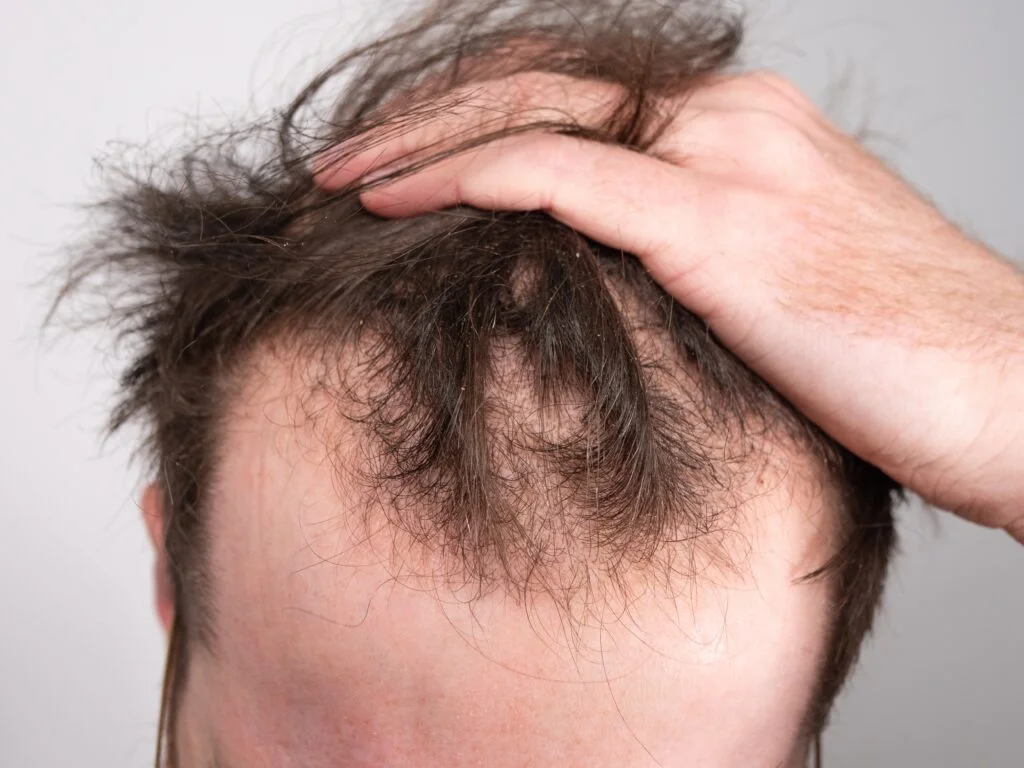Approximately 50 million men and 30 million women in the US are currently affected by some form of hair loss. While hair loss is more commonly associated with men, this statistic shows that it impacts both genders in a significant way.
While hair loss is only natural with age, many people feel their hair is part of their identity and appearance. When they start to lose it, it can therefore have a drastic effect on their mental health and self-esteem.
Hair loss can occur for a number of reasons, including genetics, hormonal changes, and medical conditions. One of the most unique and complex relationships is the link between hair loss and testosterone. While testosterone is rarely the sole cause of hair loss, hair loss and testosterone do have some unique connections as well as some common myths, which we now aim to debunk.
The Complex Relationship
As previously alluded to, testosterone and hair loss have a complex relationship. It is often believed that bald men have higher levels of testosterone. Should we take this gospel, or is it not that simple?
Generally speaking, hair loss is due to the shrinkage of hair follicles and the resulting impact on the growth cycle. New hairs become finer and finer until there’s no hair left at all, and the follicles become dormant. While this hair loss can be caused by hormones and certain genes, we may need to dig deeper to establish how testosterone results in baldness.
Does High Testosterone Cause Hair Loss?
While testosterone plays a role, it is not the direct cause of hair loss. The real culprit is a derivative of testosterone called dihydrotestosterone (DHT). This is the primary factor influencing male pattern baldness, also called androgenetic alopecia.
Some men can be genetically sensitive to this hormone, whereas others can exhibit high levels. Interestingly, some individuals have a high testosterone level but do not go bald because they are less sensitive to DHT. Similarly, some people have normal or even low levels of testosterone but do experience hair loss due to genetic sensitivity to DHT.
If not evident already, it is not as simple as high levels of testosterone equating to hair loss. Instead, while derivatives are a potential contributing factor to baldness, the relationship between testosterone and hair loss is far more difficult to understand.
How Testosterone Affects Hair Loss
DHT
As previously alluded to, DHT is a derivative of testosterone and is responsible for many male characteristics, such as body hair growth and deepening of the voice. However, when it comes to scalp hair, DHT has the opposite effect; it causes follicle miniaturisation. This process makes the hair thinner and shorter over time until the follicles become dormant, which eventually leads to baldness.
The enzyme 5-alpha reductase converts testosterone into DHT, and the higher activity of this enzyme can increase DHT levels in the body. However, not all individuals with high DHT experience hair loss, as genetic sensitivity plays a key role. Those who inherit androgen receptors that are more responsive to DHT will experience hair follicle shrinkage, particularly on the crown and temples of the scalp, leading to the classic pattern that we know of male baldness.
Testosterone Replacement Therapy
Testosterone Replacement Therapy, or TRT, is often prescribed to address low testosterone levels (hypogonadism) and the associated symptoms. The treatment aims to help them restore energy, muscles, and issues relating to overall well-being.
However, one potential side effect of TRT is hair loss. When testosterone levels are artificially increased through TRT, more of it may be converted into DHT. This can accelerate hair follicle miniaturisation, making hair loss more noticeable. It is perhaps that fact that causes so many people to believe that by increasing the testosterone levels, you drastically increase the chances of going bald. However, what is often overlooked is the fact that the treatment is only likely to involve hair loss for men genetically predisposed to androgenetic alopecia.
Androgen Sensitivity
As we’ve mentioned extensively, not everyone reacts to DHT in the same way. The key determinant of hair loss is androgen sensitivity, which is largely inherited. People with a genetic predisposition to androgenetic alopecia have hair follicles that are highly sensitive to DHT, making them more susceptible to miniaturisation and eventual baldness. Androgen sensitivity is linked to variations in the androgen receptor gene, which influences how strongly DHT binds to hair follicles.
Testosterone and Female Hair Loss
Men aren’t the only ones at risk of hair loss related to testosterone levels. Women can sometimes experience hair loss due to androgenetic alopecia. However, the technical aspects of how women lose hair are slightly different. Firstly, women have much lower levels of testosterone than men do, but there is still enough to sometimes cause androgenetic hair loss.
There is also the fact that women experience a completely different pattern of hair loss when compared to men. Whereas men’s hair loss typically involves a receding hairline, women do not suffer from such an ailment. Instead, women’s hair loss can best be described as a ‘Christmas Tree’ Pattern, as thinning occurs over the top of the scalp. Similarly to men, female pattern hair loss is typical due to the actions of DHT on hair follicles.
Are Balding Men More Virile?
Because so many people believe that higher testosterone equates to baldness, there is something of a myth going around that bald (or balding) men are more virile. As with most myths, this is not necessarily the case.
While some bald men may be virile, some men with male pattern baldness may actually have lower circulating levels of testosterone but higher levels of the enzyme that converts testosterone to DHT. Similarly, some men may simply have genes that result in hair follicles that are more sensitive to DHT.
Treatments
As with any medical condition, there are several treatments for male pattern baldness and female pattern hair loss, many of which involve tampering with testosterone levels and DHT.
Finasteride
Finasteride (Propecia) is a medication that blocks the 5-alpha reductase enzyme, preventing the conversion of testosterone into DHT. It is not suitable for women who may fall pregnant due to potential risks, and it can cause sexual side effects in both men and women. Results are usually better if treatment is started early, but regardless they’re usually pretty good. Finasteride is the second most commonly used medication for male pattern hair loss after Minoxidil.
Minoxidil
While Minoxidil is arguably the most popular treatment, it does not involve testosterone or DHT. Minoxidil works by increasing blood flow to the hair follicles, which can help to stimulate hair growth and strengthen existing strands. It is usually used alongside Finasteride, as this is the medication that tackles DHT. Side effects often include scalp irritation, itching, or redness.
Dutasteride (Avodart)
Another 5-alpha reductase inhibitor is Dutasteride (Avodart), which is currently being looked at as a treatment for male pattern baldness. It’s currently cited as a treatment for an enlarged prostate, but is being investigated for its hair-loss treatment properties.
Other Health Loss Treatments
Some of the other popular hair loss treatments that don’t involve testosterone or DHT include ketoconazole, surgical hair follicle transplant, and laser treatment.
If you are interested in learning more about health and ways to live a healthier lifestyle, be sure to keep updated with our blog. At Yorktest, we pride ourselves on empowering you to live the best life possible. We are the leading provider of at-home food sensitivity and allergy tests, so if you are experiencing issues you can’t quite explain, one of our tests may be able to help.Â











